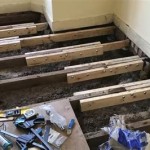Vinyl Plank Flooring On Cement: A Comprehensive Guide
Vinyl plank flooring has become increasingly popular for its durability, affordability, and ease of installation. It can be installed over various subfloors, including cement. If you're considering installing vinyl plank flooring on cement, there are a few essential aspects to keep in mind to ensure a successful installation.
1. Subfloor Preparation
The most crucial step in installing vinyl plank flooring on cement is preparing the subfloor properly. The cement surface must be smooth, level, and free of any debris or imperfections. Any bumps or unevenness can telegraph through the vinyl flooring and create an uneven surface.
To prepare the subfloor, start by cleaning it thoroughly with a degreaser or cleaner to remove any dirt, grease, or oils that may interfere with the adhesive. Once the subfloor is clean, use a level to check for any uneven areas. If you find any high spots, you can sand them down using a concrete grinder or sander. For low spots, you can use a self-leveling compound to fill in the depressions.
2. Moisture Barrier
Since cement is a porous material, it's essential to install a moisture barrier before laying down the vinyl plank flooring. This barrier will prevent moisture from seeping up through the cement and damaging the flooring.
The most common type of moisture barrier is a polyethylene sheet. Roll out the polyethylene sheet over the prepared subfloor and secure it with tape or adhesive.
3. Underlayment
An underlayment is a thin layer of material that is installed between the subfloor and the vinyl plank flooring. It serves several purposes, including reducing noise, providing cushioning, and smoothing out any imperfections in the subfloor.
There are various types of underlayments available, including foam, rubber, and cork. Choose an underlayment that is compatible with your vinyl plank flooring and the subfloor.
4. Adhesive
Vinyl plank flooring is typically installed using an adhesive. Choose an adhesive that is specifically designed for vinyl flooring and cement subfloors. Apply the adhesive to the back of the vinyl planks according to the manufacturer's instructions.
Once the adhesive has been applied, carefully place the vinyl planks onto the subfloor. Use a rolling pin or a heavy object to press the planks into place and ensure they are securely bonded.
5. Maintenance and Care
To maintain the beauty and longevity of your vinyl plank flooring on cement, regular maintenance is essential. Sweep or vacuum the floor regularly to remove dirt and debris. You can also mop the floor using a mild cleaner specifically designed for vinyl flooring.
Avoid using harsh chemicals or abrasive cleaners, as they can damage the finish of the vinyl flooring. If you spill any liquids on the floor, wipe them up immediately to prevent staining.

How To Install Vinyl Or Laminate Floors In A Basement Over Concrete Slab

Tips For Installing Vinyl Plank Over Concrete Floors Lemon Thistle

What Is The Best Flooring For Basements Get Pros And Cons

How To Prepare A Concrete Floor For Vinyl Flooring Parrys

Lvt Vs Carpet What S Better For A Basement

The Best Flooring Options For Your Basement

Installing Luxury Vinyl Plank Flooring In Our Basement Week 5 Of The One Room Challenge Willow Bloom Home

Vinyl Plank Flooring Installation Basement Remodel Before And After

Lvp Flooring Installation How To Install Luxury Vinyl Plank In A Basement Diy

Design Guide For Radiant Floor Heating In Basements With Lvt
Related Posts








